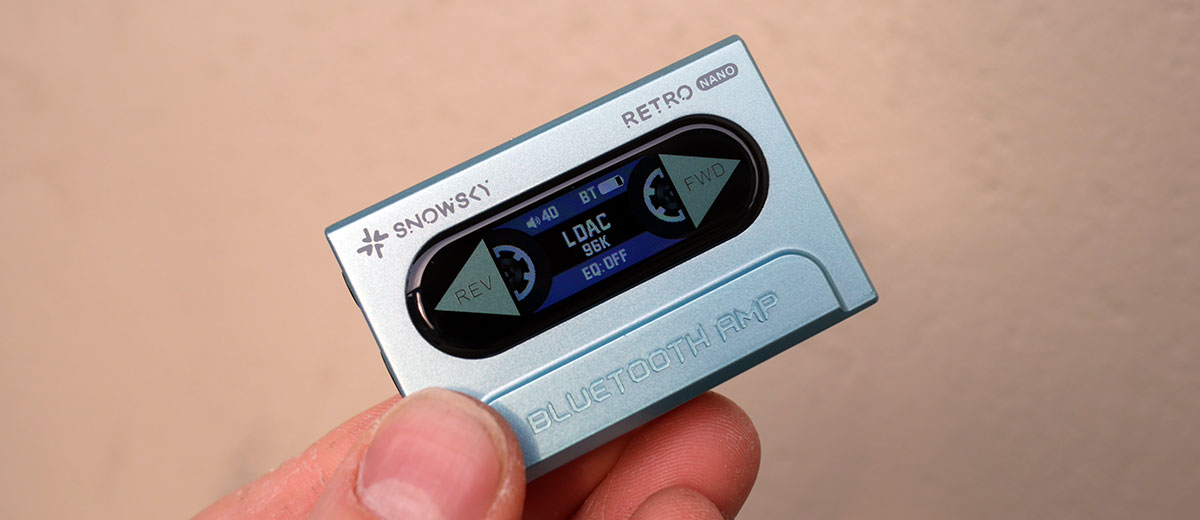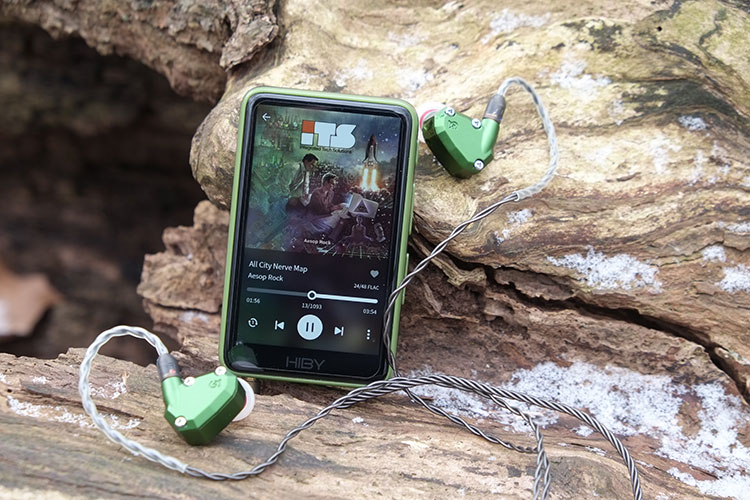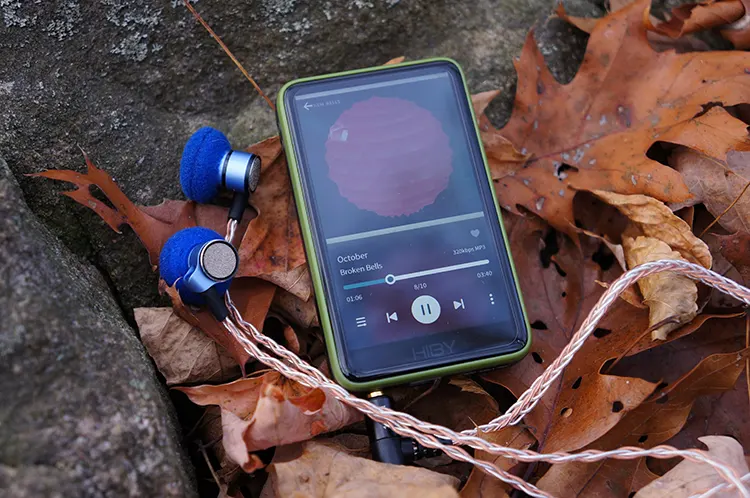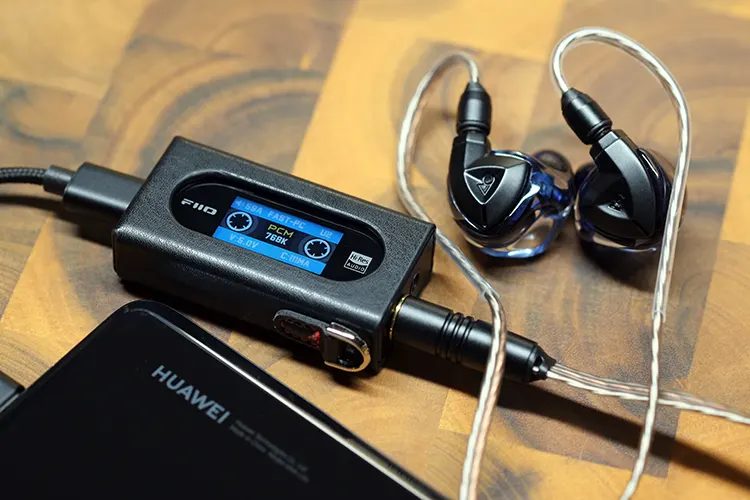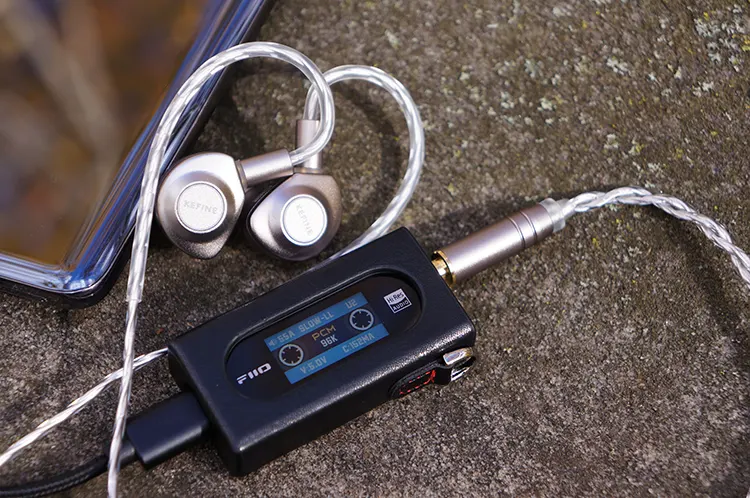Synergy
Thanks to modern hardware and extensive high-definition Bluetooth codec support, along with balanced and single-ended output options, the RETRO NANO synergizes well with various products.
The only thing holding it back is its power output, but even that is more than adequate for all but the most demanding headphones.
Efficiency
Pairing the RETRO NANO with a sensitive earphone like Campfire Audio’s Andromeda 2020 revealed a clean output. From the single-ended 3.5mm port, there was no audible hiss at any volume I was comfortable testing at.
Swapping the Andromeda 2020 to Campfire Audio’s balanced Time Stream cable to test the 4.4mm balanced out, there was an almost inaudible amount of hiss, easily masked by anything playing.
Shifting to less sensitive earphones, like the Lime Ears TERRA or KEFINE Delci AE, there was no hiss at any volume or during silent moments on a track. For a Bluetooth product, the output is impressively clean.
Power
SNOWSKY’s RETRO NANO is not a powerhouse of a receiver, outputting 100mW from the single-ended output and 220 mW from the 4.4mm balanced output.
A high gain is available in the menus, but the effect is minimal and doesn’t change the outcome to any significant degree.
While these ratings are somewhat average, the RETRO NANO is still capable of driving your average earphones to uncomfortably high volumes. Low-volume listening is also an option since you have onboard volume controls that work in tandem with the source device.
The Astrotec Phoenix is a hybrid earphone with obscene power requirements that shame many full-sized headphones. Most sources fail to push the dynamic properly, leaving it sounding anemic, and the electrostats end up splashy and uncontrolled.
While the RETRO NANO put up a good fight, the Phoenix was too much for it. The Phoenix’s performance through the RETRO NANO lacks the confidence you hear when it is pushed by more powerful devices, though this was not an unexpected outcome.
The RETRO NANO provides a usable amount of power that is good for more earphones and headphones. Just avoid the ones that work best with desktop devices.
Pairings
After using the RETRO NANO with various headphones and IEMs, I found it paired best with products with a neutral-to-bright-leaning tuning. The warmth of the RETRO NANO’s default tune balances out nicely, giving users a balanced experience.
Headphones with more detail than average also worked nicely with the RETRO NANO. It is reasonably average in that metric, and pairing it with detailed headphones produces a smooth, nuanced listening experience.
Select Comparisons
HiBy R1
Technical
The HiBy R1 provides PCM decoding up to 768kHz/32BIT with DSD 256 support, and the RETRO NANO is a little lower at PCM up to 96kHz.
The R1 utilizes a single Cirrus CS43131 DAC. The RETRO NANO uses dual Cirrus CS43131 DACs.
The RETRO NANO provides a maximum output of 100mW to the R1’s 100mW through the single-ended output. The RETRO NANO outputs 220mW via the 4.4mm balanced out, something the R1 lacks.
The RETRO NANO can drive your headphones to a higher volume, particularly from the balanced output.
Design
The R1 has a somewhat retro look of its own, harkening back to the colorful, opaque, plastic fantastic tech of the 90s. An orange screen surround adds some additional flair.
Beyond the plastic screen surrounds and sides, the R1 has glass front and back panels. In comparison, the RETRO NANO is entirely plastic, save for the glass cover for the screen.
Build quality is good on the RETRO NANO, but the R1 has tighter tolerances, less obvious seams, and a sturdier chassis. I’m sure having glass front and rear panels helps it feel like a more premium device.
While the RETRO NANO’s line of buttons on the top handles all menu navigation and device functionality, the R1 uses a touchscreen and three buttons down the side, two of which are rocker switches for volume and track navigation.
The RETRO NANO features 3.5mm single-ended and 4.4mm balanced output options down one side of the device. The R1 makes do with only a 3.5mm single-ended output on the bottom near the Type-C port and microSD card slot.
Performance Summary
Given they use the same chipset, there are many similarities in the performance of the R1 and RETRO NANO.
The pair offers a similar level of upper-end extension that allows products to reach as high as possible without feeling stunted. The R1 holds emphasis into the brilliance region a little better, though, giving it a slightly brighter tonality.
The RETRO NANO’s midrange is slightly thicker and warmer. Sibilance management is equally good from the R1 and RETRO NANO, with both doing a good job of taking the edge off tracks saddled with harsh tees and esses.
Thanks to the R1’s slightly cooler tuning, it sounds more natural. The RETRO NANO’s denser, warmer sound shifts the timbre in a way that only benefits select tuning styles.
Extension into sub-bass regions is equally good, with deep notes providing a welcome visceral response. The RETRO NANO’s bass presentation is slightly thicker, though due to a hint of more mid-bass emphasis, reducing detail and texture compared to the R1.
Both have a great sound stage, with neither having a technical edge to my ear. They sound equally open, with competent instrument separation and layering qualities.
Imaging accuracy is the same with sounds moving from channel to channel equally smoothly. They both provide accurate movement off-center and to the edges of their respective stages.
Detail and clarity overall are ever so slightly better from the R1. I attribute this to the extra upper treble emphasis and reduced mid-bass presence.
FiiO KA15
Technical
The KA15 provides PCM decoding up to 768kHz/32BIT with DSD 256 support. while the RETRO NANO provides PCM decoding up to 96kHz. The KA15 utilizes dual Cirrus CS43198 DACs. The RETRO NANO uses dual Cirrus CS43131 DACs.
The RETRO NANO provides a maximum output of 100mW to the KA15’s 180mW through the single-ended output. Via the balanced output, the RETRO NANO outputs 220mW compared to the KA15’s 560mW.
The KA15 can drive your headphones to a considerably higher volume, especially from the balanced output.
Design
The KA15 is a small matte black monolith of a device with its dominant feature being the 0.96” display. This is the same display used for the RETRO NANO, though with a glass cover that features cassette-inspired “Rev” and “Fwd” wording as opposed to the FiiO and Hi-Res Audio branding seen on the KA15.
Both feature numerous controls on top. The KA15 has four, one of which is a slider switch for its desktop mode, while the RETRO NANO has five, one of which is a power slider.
Both feature a Type-C port and lanyard connection point. They both also feature 3.5mm single-ended and 4.4mm balanced ports.
The build quality of the KA15 is a significant step up, thanks to the use of aluminum for the shell as opposed to the plastic used for the RETRO NANO. The KA15’s tolerances are also much tighter, with near-invisible seams.
Performance Summary
The pair provides a similar upper-end extension, with the KA15 carrying more brilliance region emphasis, giving it a brighter overall sound.
Detail and clarity are firmly in the KA15’s camp, resulting in these elements providing better dynamics, layering, and note control.
The RETRO NANO’s midrange is thicker and warmer, and as a result, clarity and micro-detail take a hit when compared to the KA15. Sibilance management is slightly better from the SNOWSKY, with harsh tees and esses sounding less forgiving, though still very manageable, from the KA15.
While still slightly warm leaning, the KA15 provides a more natural timbre that minimally influences whatever is plugged in.
Extension into sub-bass regions is similarly good, however, RETRO NANO is a step down when looking at detail and texture, though.
Both have a great sound stage, with the KA15 having the edge. It sounds just a little more open, with improved instrument separation and layering.
Imaging accuracy is about the same with sound moving from channel to channel smoothly. Even off-center and to the edges, the RETRO NANO fares well against the KA15.
My Verdict
While I can agree that the casual aesthetics may be a turnoff to some, if you can step back and take the hobby less seriously, it’s hard to argue against the visual appeal of the FiiO SNOWSKY RETRO NANO.
With its sky blue finish, mini-cassette aesthetics, a modern wireless chip with fantastic codec support, balanced output, replaceable battery, and the ability to run as a wired DAC, it is hard to believe it costs well under $100.
That’s not even accounting for the mini-screen and onboard GUI, including custom and preset EQ options and background customizability, among other features. The RETRO NANO is a feature-packed dongle DAC and provides what I’ve come to expect from a FiiO sub-brand: value and capability.
That’s not to say it’s perfect. The battery life doesn’t last an entire day of work, leaving me wishing that the protective battery case they included was filled with a bonus spare.
While the RETRO NANO’s aesthetics are great and the all-plastic build unexpectedly sturdy, the battery door doesn’t give me confidence that it’ll stand the test of time.
The power output is somewhat meager, even through the balanced output, but given the price, sound, and feature set, and that in practice it has been enough for 99% of what I use regularly, I can forgive this.
Overall, I quite enjoyed my time with the RETRO NANO. It will happily accompany the M1 Plus in my everyday carry kit, as it has shown itself to be a valuable addition.
FiiO SNOWSKY RETRO NANO Technical Specifications
- Bluetooth Chip: QCC5125 (CPU+DSP dual-core architecture)
- DAC: dual CS43131
- Bluetooth Version: 5.1
- Codecs: AAC/SBC/aptX/aptX LL/aptX Adaptive/aptX HD/LDAC
- USB DAC: driver-free up to PCM 96K
- Display: 0.96” 80×160 color IPS
- Headphone Outputs: 3.5mm single-ended + 4.4mm balanced
- In-Line Controls: Supports microphone, volume adjustment, and play/pause control in CTIA protocol
- Color: White/Blue
- Dimensions: 55.1mm x 37.5mm 13.7mm
- Weight: 28.3g (including battery)
- Battery: 3.7v rechargeable lithium
- Battery Life: ~7.5 hours
- Single-Ended Output Power: L+R 100mW+100mW (32ohms, THD+N <1%)
- Balanced Output Power: L+R 220mW+220mW (32ohms, THD+N <1%)
- Frequency Response: 20Hz-40kHz (-3dB)
- Output Impedance: <0.3ohms (32ohm load)

